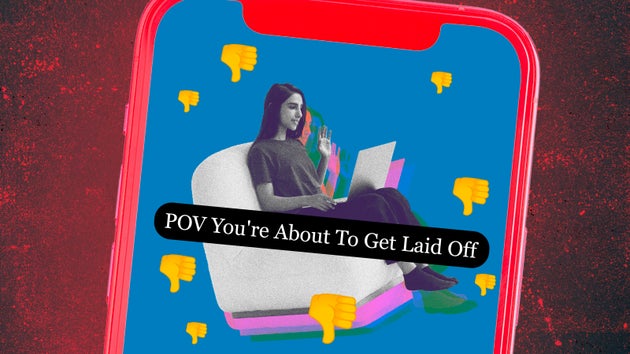 A former account executive at a cybersecurity firm is part of a growing number of people who are filming the exact moment they got laid off and are sharing the real-time reactions on TikTok.
A former account executive at a cybersecurity firm is part of a growing number of people who are filming the exact moment they got laid off and are sharing the real-time reactions on TikTok.On Jan. 12, Brittany Pietsch, a former account executive at cybersecurity firm Cloudflare, posted a nine-minute video to TikTok. The caption read: “POV: you’re about to get laid off.”
In the video captions, Pietsch explains that her work friend got laid off 30 minutes before she did so she knew what was coming. Pietsch identifies the other speakers on the remote call as an HR representative and a director that she did not know. They tell her she has not met performance expectations and the company is parting ways with her. But Pietsch does not accept this explanation.
“Every single one-on-one I’ve had with my manager, every conversation I’ve had with him, he has been giving me nothing but, ‘I am doing a great job,’” she told the two staffers.
In the video, Pietsch questions why two people she has never met are doing this instead of her manager. She presses the unidentified team on the call to explain why she is being let go, but does not receive specific answers.
“Do you guys even know who you’re talking to?” Pietsch cuts in at one point. “It just doesn’t make any sense that you guys have still not been able to give me a reason why I’m being let go.”
Pietsch is part of a growing number of people who are filming the exact moment they got laid off and sharing the real-rime reactions on social media for all the world to see.
Publicly sharing vulnerable life experiences online isn’t new. But these real-time layoff videos are changing the narrative about how layoffs are conducted. Typically, these remote terminations are done by an HR representative or an executive mechanically reading off of a script on a Zoom call. It can be an isolating, impersonal experience for employees having their livelihood taken away through a computer screen.
But when you hit record and share exactly how these managers told you the news ― particularly if you believe the layoff was poorly handled or unjust ― you can get immediate support for how you’re feeling.
“You’re eating them up, soooo valid,” one top comment on Pietsch’s TikTok reads.
But before you hit the record button for yourself, know that posting a layoff video on social media can also come with significant legal risk.
Why recording your remote layoff can be legally risky
A majority of states have one-party consent for recording laws, meaning you can hit record without letting the other person know or agree to be recorded.
But there are about 11 states, including California, Delaware, Florida, Illinois, Maryland and Massachusetts, that require “all-party consent” for recording, meaning everyone on the call must agree to be recorded.
But even if you’re in a jurisdiction with a one-party consent rule, you also have to consider if the HR representatives or managers in your Zoom call are also in a one-party consent jurisdiction, too.
That’s why recording a remote work call “could present different complications, as in which jurisdiction has the controlling law,” said Robert Baldwin III, founder and managing attorney at Virtue Law Group. “In some places, it is the place where the call originated. In other places, it is the place where the recorder exists.”
Getting unfairly fired is a scary, embarrassing and lonely experience. Employees are seeking solidarity.Ryan Stygar, employment attorney
Because the law is so “murky,” Baldwin recommends talking to an attorney in your jurisdiction to get clarity before you post your recorded video call.
Editing out the recordings of people who did not explicitly consent can potentially be less legally risky. Take how one tech employee recently filmed her shock when she got laid off, but read aloud the announcement instead of including audio of the exact voices from management. That distinction can make a difference if you’re filming in an all-party consent state for recording, said Florida-based employment attorney Donna Ballman.
“This would get around the issue of recording a conversation with someone else,” Ballman said.
And if you’re filming your layoff for evidence of wrongdoing, understand that you don’t only have to record a conversation to prove your word against your company’s. You can also write or email yourself a contemporaneous record of what was said, and who or what was present in these meetings for future lawsuits.
Understand what posting a layoff video can and can’t do
Legal and HR experts caution employees to be clear about why you’re posting the layoff video. California-based employment attorney Ryan Stygar said that if you want to do it because you feel your termination wasn’t fair, you should consult with an attorney first because “what’s unfair is not always illegal.“
He recommended doing a risk assessment and asking yourself: “What unfair or unethical business practices are you trying to expose? How will doing so affect you or your case? And is it worth it?”
Jie Feng, an associate professor of human resource management at Rutgers University, said if your video is a form of whistleblowing that aims to expose critical wrongdoings, posting your layoff online could end up being necessary. But if you are posting to get emotional support during a challenging time and the layoff isn’t necessarily illegal, Feng said there may be less risky, alternative options to get that support ― like going to your union or getting help from your relevant professional association.
Be careful about how you edit the layoff video
On TikTok, it’s popular to add captions, flashy transitions and emotional soundtracks to make mundane “Get Ready With Me” videos feel like a movie where you’re the protagonist. Last April, a woman posted a TikTok montage from the day of her layoff, and edited the scenes to look like a Wes Anderson film, as one example.
But these narrative videos often focus on only one perspective: yours. Employment lawyers warn that editing the layoff video to make it look worse than what it actually was could get you sued under what is known as a “false light” claim.
“If you extract a portion of the conversation from the larger context, then it can mislead the audience if you decide to publish that online,” Baldwin said. “That’s something that people can be sued for as well.”
And you should be cautious about how you talk about your employer in the video, too. Stygar said the most immediate risk that employees posting these layoff videos will face is a defamation claim.
“The commentary surrounding the recording, such as your caption, your text overlay, or any comments you make can become a basis for a defamation suit if your statement is false, malicious and causes some backlash,” he said.
Why the trend of filming your layoff lives on despite the risks
The power of a “Get Laid Off With Me” video is how it brings you along on someone’s life-changing day. Unlike the previous trend of people filming the triumphant moment they quit their toxic jobs for TikTok, layoff videos have more inherent uncertainty over what’s going to happen next.
These layoff videos can feel voyeuristic because as a viewer, you can see the shaky nerves and crestfallen expressions going across the person’s face, but that’s also exactly what keeps thousands of viewers watching.
You watch the employee worry aloud about the surprise meeting on their calendar with HR, and wait to get news they suspect is coming but don’t want to hear. Some tear up, some want explanations, and all make you feel a little queasy for witnessing the moment a person gets their world turned upside down.
“Are you as uncomfortable as me?” says one woman at the end of her TikTok video in which she films the day of her January remote layoff minute by minute. “Thanks for joining me on this weird-ass journey,” the woman concludes to the camera.
Although it may not help you in an actual court of law to share such a video, it could help you win over sympathetic viewers in the court of public opinion.
“The legal consequences of posting online tend to favour the employer, but the social consequences tend to favour the employee,” Stygar said.
In this way, these public videos put executives on notice, too. They can serve as a deterrent to employers to be more careful and humane about how they conduct layoffs.
The most common message I’m receiving is how many people have experienced something shockingly similar.Brittany Pietsch, former Cloudfare employee who filmed her layoff
“Getting unfairly fired is a scary, embarrassing and lonely experience. Employees are seeking solidarity,” Stygar said. “By sharing experiences which employers would prefer to keep in the dark, workers are putting pressure on companies to behave ethically.”
Cloudfare did not respond to HuffPost’s questions about Pietsch’s layoff. On X, the Cloudfare CEO shared that Pietsch’s video was “painful” to watch because “managers should always be involved” and “no employee should ever actually be surprised they weren’t performing.”
Pietsch did not respond to HuffPost’s request for an interview, but since her video, Pietsch has shared in a LinkedIn post that “the most incredible outpouring of support has honestly restored my faith in the corporate world.”
In this way, posting your layoff video on TikTok can help you feel less alone.
“While social media does come with limitations and challenges, it has evolved into an invaluable channel for the younger generation to seek emotional support during difficult times, such as job loss,” Feng said.
“The most common message I’m receiving is how many people have experienced something shockingly similar,” Pietsch said in her post. “All people saying they wish they would have stood up for themselves as I did.”





